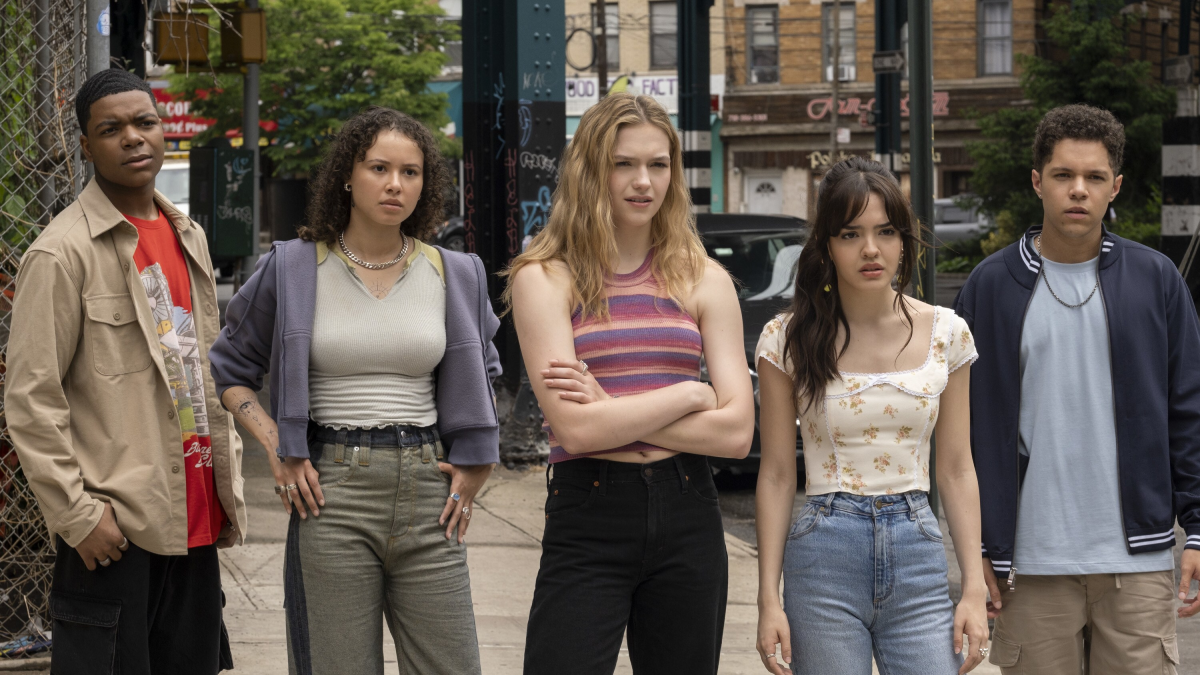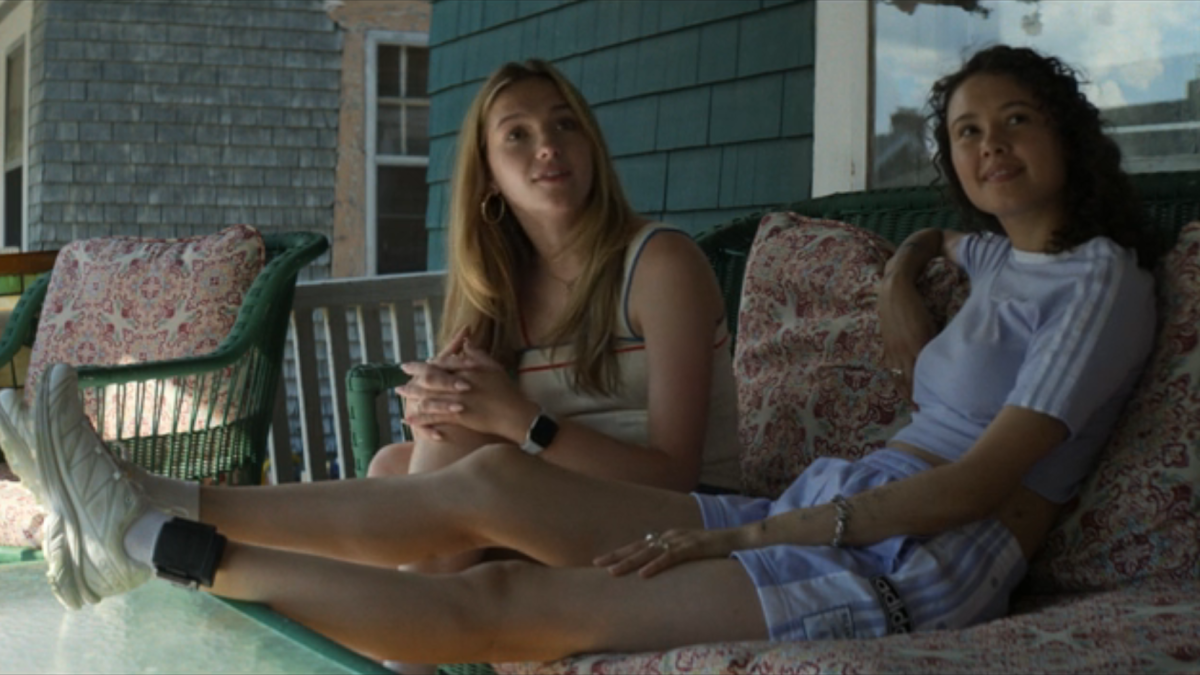Goosebumps is back with a spooky second season full of evil plants and strange monsters, plenty of classic book references, and a couple of queer teens.
Based on the R.L. Stine books of the same name, this series ties together multiple classic stories that spooked us as children in the 90s into a cohesive season. The first season was very Night of the Living Dummy focused, but this season — called The Vanishing — leans more into Stay Out of the Basement and Invasion of the Body Squeezers. This season also has a sapphic teen storyline that is one of the most matter-of-fact and chill queer storylines I’ve seen from a Disney show.
In this season, David Schwimmer plays Anthony, a botanist, whose twin teens Cece (Jayden Bartels) and Devin (Sam McCarthy) are coming to stay with him for the summer. While there, they meet troublemaker Alex (Francesca Noel), shit-stirrer Trey (Stony Blyden), entrepreneurial and charming CJ (Elijah M. Cooper), and Devin’s childhood crush/Trey’s on-again off-again girlfriend, Frankie (Galilea La Salvia). While they clash initially, the group becomes reluctant friends as they get tangled up (sometimes literally) in the mystery of teens that went missing 30 years ago.

Hi, teens! (Disney/Francisco Roman)
You see, way back in 1994, Anthony’s brother and his friends went to investigate a creepy abandoned fortress rumored to have been used for military science experiments and were never seen or heard from again. In 2024, only Anthony and his brother’s ex Jen (now a police detective) know that the teens didn’t run away or drown, but something…inexplicable and possibly supernatural happened to them.
While they go on this adventure, Cece and Alex find themselves in a bit of a banter-filled flirtationship. The way they go about revealing both girls are queer is really subtle and felt very Gen Z in a way a lot of the other dialogue didn’t necessarily. There are no coming out moments, no misunderstandings or assumptions, no discussions about it at all. At one point, Alex mentions rolling a vending machine off a pier to impress a girl, and Cece’s only reaction was to smirk and ask if it worked. Later, Cece mentions noticing Alex flirting with her, says she’s not NOT into her, etc, letting US know where she stands, though it seems it was always clear to Alex. And at one point when Cece comments on a man being attractive and receives an eyebrow quirk from Alex, she shrugs and says “sexuality is a spectrum” and is met with smiles before everyone moves on. (Also the man in question is played by Sendhil Ramamurthy, who is objectively attractive and while Cece’s answer is very valid for her and great to hear from a kids’ show, my answer would have been, “I’m gay, not blind.”)
With an ensemble cast and a lot going on, there isn’t much time spent on the Cece/Alex relationship, which can make some of the progression feel a little rushed at times, but not in a way that feels neglectful or different than any other B-plots of the show. In episode six, credited to lesbian writer Mariko Tamaki, Cece and Alex find themselves feeling the mounting pressure of the dangers before them and the tasks they’re about to set off to do, and decide to not waste time in case it’s their only shot and they kiss. What’s remarkable about this isn’t necessarily the kiss itself — though it’s nice that the camera centers them and the music swells — but that it is one of, if not THE, only kiss in the show. It’s definitely the most important kiss if it isn’t the only. And like I said, the relationship overall isn’t a huge, important part of the story, but it’s given as much weight and importance, if not more, than Cece’s brother Devin’s love triangle storyline with Frankie and Trey. It’s a very refreshing take on a queer relationship in a children’s TV show, and I guarantee that care and thoughtfulness was largely due to their being a lesbian writer in the room. As a little cherry on top: both of the actors are queer, too (and even went to Pride together once).

Look at these cutie patooties.
Overall, Goosebumps: The Vanishing is a cute horror-lite children’s series. It keeps the tone of the Goosebumps books, which is very much “baby’s first horror story.” The stakes are low and the solutions are relatively simple. While the dialogue sometimes feels like it was written by someone who has never spent time with actual teenagers, that frankly fits with the tone of the Goosebumps books. It’s not teenagers how they see themselves or how teenagers see them, it’s teenagers how a little kid might see them. It’s also not like Fear Street, where teens are getting stabbed to literal death left and right in Shadyside. In fact, similar to how the Fear Street books are YA while the original Goosebumps series is more middle grade/children’s lit, the vibes of the adaptations follow suit. This Goosebumps series is definitely meant for the Disney Channel (RIP) audience, who would already know some of the show’s stars from their previous roles. Where Fear Street is about teens but aimed at a “teens and up” audience, Goosebumps: The Vanishing is about teens but aimed more to “up to teens.” That is neither good nor bad, just something to know going into it. This isn’t teen horror on the level of, say, Stranger Things, Yellowjackets, or even Pretty Little Liars. That said, the intended younger audience makes the queer representation on this show even more special and important, especially given how often we hear of companies with younger audiences balking at (or fully removing) queer content in their shows and movies. (Looking at you, Pixar.)
Goosebumps: The Vanishing is exactly the kind of show I would have been obsessed with when I was in grade school in the 90s, and I’m so glad there are little queer grade school kids who get to see themselves in a show like this in the 2020s.
Goosebumps: The Vanishing is now streaming on Disney+.



Are you serious with this article? This show was amateurish and terrible. David Schwimmer is the only saving grace of this tired and lifeless exercise in tedium. As for queer representation, it is baffling to me that is even a metric to judge a film or TV show’s quality. Your sexuality isn’t what makes you compelling. But if you really are hung up on it like so many of these so called modern “critics” are, the lesbian relationship was much more heartfelt and beautifully done in a show like The Haunting of Bly Manor. Here it just involves a bunch of poorly acted teenage stereotypes with zero chemistry. Seriously all of the actors in this show are terrible and not believable in the slightest. Definitely would not recommend this season to anyone.
Woke trash, how about you go make your own damn show if you want this. Oh right, every time you do it fails. Concord much? That’s why they have to highjack popular franchises, dr who, goosebumps, saints row, should I keep going?